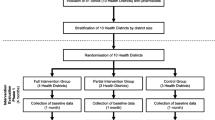Abstract
In many countries, prescription data are used as an instrument to provide feedback on prescribing. This article describes the development and implementation of a computer program as a tool for pharmacotherapy audit meetings and it illustrates the possibilities of such a program. The program was developed to support the optimisation of prescribing in the various stages of behavioural change. It enables pharmacists to make sophisticated overviews of prescribing by physicians in their audit group and furthermore, pharmacists can conduct drug utilisation studies or pharmaco‐epidemiological studies in their own patient population. Forty percent of Dutch pharmacies have purchased the computer program since its introduction; it was distributed together with a technical handbook and a course book, which elaborated on the types of graphs available and their interpretation. An educational course was developed regarding the optimal selection and interpretation of graphs. Examples of prescription data as a tool to support various aims of audit meetings are given. The program is acknowledged as a welcome contribution to pharmacotherapy audit and to the pharmacists' advisory role in pharmacotherapy.
Similar content being viewed by others
References
Bradley CP, Taylor RJ, Blenkinsopp A. Developing prescribing in primary care. BMJ 1997;314:744-7.
van Mil JWF, Tromp ThFJ. Pharmaceutical care in the Netherlands. History, definition and projects. Pharm World Sci 1996;18(6):237-40.
Hepler CD, Strand LM. Opportunities and responsibilities in Pharmaceutical Care. Am J Hosp Pharm 1990;47:533-43.
Bradley M. The role of the pharmacist-the new member of the team. VFM update 1996;2:27-8.
Schneider JS, Barber ND. Community pharmacist and general practitioner collaboration in England and Wales. Pharm J 6 Bradley C. Promoting practice services-prescribing in general practice. Horizons 1993;7:115-7.
Shane RR. Pharmacy without walls. Am J Health Syst Pharm. 1996;53(4):418-25
VonFerber L. Auditing drug therapy by peer review-the German experience. Pharmacoepidemiol Drug Safety 2:195-200.
McGavock H. Rational discussion as a guide to more costeffective and scientific prescribing in general practice: 15 years of experience in Northern Ireland. In: Kochen MM, ed. Rational Pharmacotherapy in General Practice. Berlin Heidelberg: Springer-Verlag, 1991;186-200.
Baert AE, Baig SS, Bardoux C. Effects of group auditing on improving drug therapy in primary care: a randomized controlled trial. IOS Press, Amsterdam 1995;22-3.
Avorn J, Soumerai SB. Improving drug-therapy decisions through educational outreach. N Engl J Med 1983;308:1457-63.
May F, Gilbert A, Hurley E, McNeece J, Rowett D. A drug and therapeutics information service for community medical practitioners. Australian Prescriber 1993;16:49-51.
Chapman S. Community pharmacists have positive IMPACT. VFM Update 1996;2:8-9.
Stichting DGV. Jaarverslag [Annual report]. Stichting DGV 1996.
de Vries CS, de Jong-van den Berg LTW. Farmacotherapie overleg in de praktijk. [Pharmacotherapy audit in practice]. Groningen Institute for Drug Studies, Groningen, 1997.
de Smet PAGM. The KNMP drug data base as a tool for Dutch drug utilization research. In: Bakker A, Hekster YA, Leufkens HGM. Drug consumption in the Netherlands Volume I. Noordwijk, Amsterdam Medical Press b.v. 1991.
Herings RMC. PHARMO: a record linkage system for postmarketing surveillance of prescription drugs in the Netherlands. Utrecht: Utrecht University 1993. Dissertation.
de Vries CS, Tromp ThFJ, de Jong-van den Berg LTW. Feedback on prescribing. In: Buurma H, Hekster YA, Bakker A, Leufkens HGM (Eds). Drug consumption in the Netherlands, Volume II. Groningen, Styx publications 1997.
de Vries CS, Tromp ThFJ, Blijleven W, de Jong-van den Berg LTW. Prescription data as a tool in pharmacotherapy audit. Pharm World Sci 1998;21:80-4
World Health Organisation Collaborating Centre for Drug Statistics Methodology. Anatomical Therapeutical Chemical (ATC) classification index including defined daily doses (DDDs) for plain substances. Oslo: WHO, 1997.
Rosmalen CFH, Thomas S, van der Laan JR, van Lennep MJ, Vink R. Farmacotherapie voor de huisarts. [Pharmacotherapy for the general practitioner] Utrecht: Nederlands Huisartsen Genootschap 1996.
Petri H, de Vet R, Naus J, Urquhart J. Prescription sequence analysis. Stat Med 1988;7:1171-5.
Lamberts H, Wood M. International Classification of Primary Care. Oxford: Oxford University Press, 1987.
World Health Organization. International Classification of Diseases-10th revision. WHO, 1992.
Rights and permissions
About this article
Cite this article
de Vries, C., van den Berg, P., Timmer, J. et al. Prescription data as a tool in pharmacotherapy audit (II) the development of an instrument. Pharm World Sci 21, 85–90 (1999). https://doi.org/10.1023/A:1008665731627
Issue Date:
DOI: https://doi.org/10.1023/A:1008665731627




